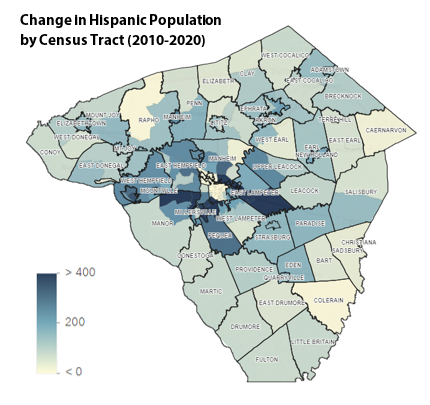In this month’s policy blog, CPFB Policy Research is highlighting a key finding and recommendation from our Lancaster County Community Hunger Mapping report, which we released in August 2023. Writing and releasing the report was just one step in working to improve the charitable food system in Lancaster County; CPFB and its partner agencies, as well as other community stakeholders, are now actively using the findings and recommendations made last summer to implement changes that will make a difference for our food insecure neighbors.
One of the most meaningful changes we can make is ensuring that culturally familiar foods are available to all neighbors, which reflects not only our research findings but also our commitment to equity, diversity, inclusion, and belonging. Food has cultural significance as well as health impacts, and providing foods that people know and use is an important part of a dignified pantry experience.
Like the rest of the nation, Lancaster County is becoming increasingly diverse. In Lancaster specifically, the most visible indicator of changing demographics is the significant increase in the Hispanic or Latino population of the county. Between the 2010 and 2020 Census, Lancaster’s Hispanic population grew nearly 30%, from 8.6% of countywide population to 11.1% of countywide population. The map at right shows the census tracts in which the changes were most pronounced.
Hispanic individuals in Lancaster County are disproportionately likely to face food insecurity, with a food insecurity rate of 21% as opposed to 9% for the overall population and just 6% for non-Hispanic white individuals as of 2020, according to Feeding America’s Map the Meal Gap estimates. This extreme inequity in food insecurity rates by ethnicity means that, if we are to equitably serve all our neighbors in need, the charitable food network must ensure that the foods available at food pantries include foods that are familiar to Hispanic individuals, as they are more likely to be food insecure and accordingly more likely to visit pantries than the overall population.

It is also important that the charitable food network recognize that Hispanic communities, and indeed all racial and ethnic groups, are not monolithic and that culturally familiar foods can and do vary by nationality. To better understand the food preferences of neighbors who visited food pantries in the context of ethnicity and nationality, CPFB Policy Research used a two-question approach within the surveys conducted as part of the primary data collection phase of Community Hunger Mapping. First, we asked neighbors if they identified with any cultures or countries outside the mainland United States, and if so, which one. Then, later in the survey, we asked if they had any specific food items they needed or wanted but could not readily get from the food pantry.
By taking this approach, we were able to break out responses for individuals who identified with two nationalities – Puerto Rico and the Dominican Republic. These two national ancestries are also two of the three largest non-Western European ancestry groups in Lancaster County as of 2020 according to the 2020 5-Year American Community Survey, with more than 36,000 Puerto Rican individuals and just over 5,000 Dominican individuals.
Interestingly, we received the same number of survey responses from both Puerto Rican and Dominican-identifying individuals, at 40 each, even though the Puerto Rican population is more than seven times larger than the Dominican population. Additionally, we received only three responses from individuals identifying as Mexican, even though the Mexican population in the county is about the same size as the Dominican population. More research is needed to determine if these are simple sample effects or if there are significant pantry utilization gaps by ancestry within Lancaster’s Hispanic community.
The results of our food preference analysis by ancestry can be found in the table at right, along with the overall preferences from all respondents. Three quarters of all respondents to the survey listed at least one item they need or want but cannot always get from the food pantry, and more than half (57%) listed three, the maximum number for which there was space. Overall, the most requested item by far was meat, with 44% of respondents indicating but they would like but cannot always find meat at food pantries; eggs and vegetables came in a distant second at 12%. Produce and milk were the only other foods requested by more than 10% of respondents.
| Rank | Overall | Puerto Rico | Dominican Republic |
| 1. | Meat | Meat | Rice |
| 2. | Eggs | Eggs | Meat |
| 3. | Vegetables | Milk | Milk |
| 4. | Produce | Produce | Vegetables |
| 5. | Milk | Rice, Beverages, Vegetables | Eggs |
Requested food items did not differ significantly by culture, with the important exception of rice. Rice was the number one request among Dominican respondents and tied for fifth among Puerto Rican respondents but did not appear at all in the overall top five. Notably, some neighbors simply wrote “Hispanic food” or “Puerto Rican food” in the preference boxes, which indicates that the charitable food network in Lancaster County needs to further invest in understanding and acquiring culturally familiar foods, such as rice, for these communities.
In light of these findings and other learnings about cultural food needs across our service territory as part of other Community Hunger Mapping projects, CPFB Policy Research has teamed up with CPFB Nutrition to conduct a comprehensive study of culturally familiar foods with an eye toward improving our sourcing so that we can offer a robust array of foods to our neighbors. We are engaging with cultural organizations across our service territory, such as the Spanish American Civic Association (SACA) in Lancaster, to conduct in-depth qualitative interviews; these interviews will help us learn more about specific food preferences and flavors within cultures, understand cooking techniques, styles, and recipes, and identify foods and beverages that are common parts of cultural and religious holidays to ensure that each and every neighbor has the opportunity to visit a pantry and go home with food that is not only nutritious, but also delicious, for them and their families.
